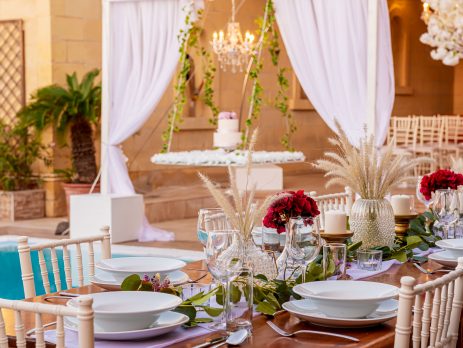Wedding seating plan – Who should sit where?
All of these are serious bugbears for any bride and groom-to be, but one of the most stressful decisions when planning a wedding must be deciding who should sit where.
Since this is one of the notoriously hard parts of getting ready for the big day, we’ve put together some helpful tips to assist you with setting out your seating plan.
Understanding wedding seating plan etiquette
It goes without saying that the top table is at the centre of attention, with all guests wanting to catch a glimpse of the happy couple.
Therefore, let’s begin by looking at how the top table is traditionally organised.
The top table is conventionally made up of the wedding couple, their parents, the chief bridesmaid and the best man. But how do you seat everyone in this equation happily?
The customary order would be, for an example, from left to right, to have the groom’s father, the bride’s mother, then the groom and his bride, followed by the bride’s father and the groom’s mother. But what do you do if one or both sets of parents are divorced, or if there is an absent parent?
More complications arise when you have multiple best men or maids of honour in your wedding party.
Now, let’s consider how to make a wedding seating plan.
Creating a wedding seating plan template
It may sound simple, but the key to a successful seating plan arrangement is to set out a template and to keep on working on it until you and your partner are totally happy with the decisions you have made.
Seeing as the top table is such a focal point, we would suggest starting there.
Having discussed the format of the tables with your wedding venue (i.e. whether they offer round or rectangular tables, how many people can be seated at one table, where those with impaired mobility or families with young children should ideally sit, etc…), ask them for a blank template or create your own basic drawing of the ceremony room and begin planning.

Tips for a stress-free wedding seating plan
See our top tips below for making this part of your wedding planning free from tension. We are sure that both of you will agree on these suggestions!
- Start your seating plan template early but don’t create the final chart until late, as it will no doubt be subject to change.
- Table numbers can be viewed as hierarchical so consider using table names instead.
- Use a pin board for your template so that you can easily move guests from one position to another without having to start over each time.
- Always sit younger children with their parents, however, there is no harm in sitting teens together at a separate table.
- Don’t sit elderly guests too near any speakers as they may struggle to cope with the noise level.
- Think about who needs the easiest access to toilets (i.e. potty-trained children, wheelchair users, pregnant ladies, those with injuries).
- If any of the guests are divorced or simply don’t get on then it may life easier to make sure they are not seated close to each other!
- Aim to keep groups together where possible, such as family, friends and work colleagues.
- If possible, try not to separate couples, even if only one of them is in the bridal party.
- Remember to do whatever feels right for you and don’t feel pressured by anyone to put certain guests in certain seats.
By Warwick House


